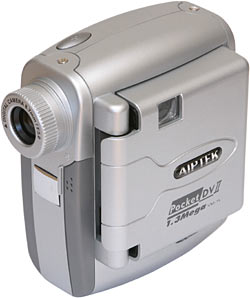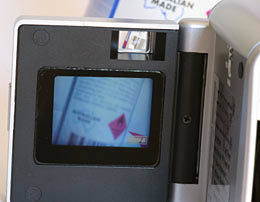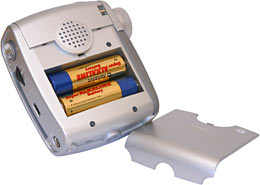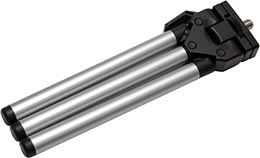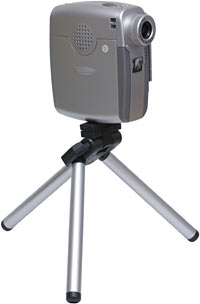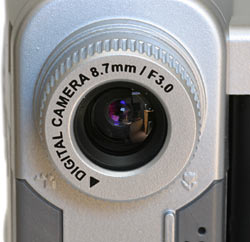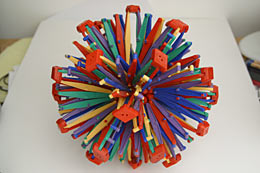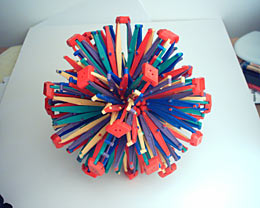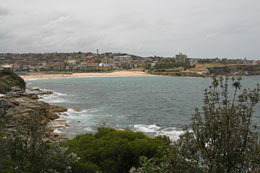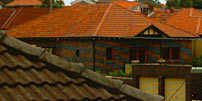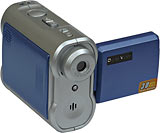
Aiptek Pocket DV2 digital camera
Review date: 24 January 2003.Last modified 03-Dec-2011.
I like baby digital cameras. Little plastic toy-cams that cost about the same as a half-decent point-and-shoot film camera are, of course, not nearly as technically capable as certain far more expensive gadgets I could name, but they have many redeeming features. Apart from the fact that regular humans can afford them, baby-cams are also small and light and, generally, very easy to use.
And this, for the time being at least, is the king of the toy-cams.
(UPDATE: Now there's a better one!)
Aiptek's Pocket DV2 does, in a nutshell, everything.
It takes 1280 by 1024 still photos (or 640 by 480, if you want more pictures per megabyte; there are two different JPEG compression settings, too). It records video clips. It records audio - along with the video, or by itself. It's got A/V output, so you can plug it into a TV or VCR for live video (bingo, instant security camera) or playback. It's got some built-in memory, but it can also accept a Type I CompactFlash card, of up to 512Mb capacity; insert a card and it'll save to that instead of its internal memory.
It's got an optical viewfinder, of sorts, and a little LCD screen too.
It connects to a PC via USB and works as either a flash memory storage device (and, thus, as a CompactFlash card reader as well) or as a normal tethered webcam.
It doesn't make you use awful patronising Leg-Up Program software.
It comes with a little tripod.
It runs from two AA batteries, and will run for quite a long time from rechargeables. It doesn't need batteries at all, in tether-cam mode.
It's not without its quirks, but it's got less of them than many of these sorts of devices. I'm used to baby-cams with painful problems that're the result of the abbreviated development process needed to get such low-dollar devices onto the shelves before they're outdated. The Pocket DV2 is pleasingly free of such issues, except for a couple that I'll get to in a moment.
The Pocket DV2 costs $AU253, delivered, from Aus PC Market (Australian shoppers who're sold on the idea already can click here to buy one). The US list price for the Pocket DV2, as I write this, is $US129.95, with a few discounters selling them cheaper.
So this thing is about a hundred Australian bucks cheaper than the cheapest of the "proper" digital cameras - like this one, for instance. It pays to keep that fact in mind when you're playing with the Pocket DV2. At this price point, if you've got a use for all or most of its features, it's really rather brilliant.
The camera
Aiptek have deliberately styled the Pocket DV2 to look like a camcorder...
...right down to the fold-out LCD screen. The screen's just on a simple 90 degree hinge, not the multi-axis swivel mounts that proper camcorders have. But the fold-out system is still neat, and protects the screen from damage when it's closed.
The LCD is a 1.4 incher, which is to say, it's really small. It's also very low resolution, and not terribly high contrast, and practically impossible to view in sunlight. It generally gives the strong impression that if Aiptek are paying more than $US5 per unit for the LCD panels, they're being robbed.
But, I remind you, this is a cheap camera. That it has an LCD at all is remarkable.
There's a simple optical viewfinder above the LCD, which is a strange little thing. It's placed so that you can't easily put your eye to it, and if you try, you just see a blur. You're meant to look at it from a normal LCD-viewing sort of distance. Then, it gives you a focussed image, but one that's only the size of the average little fingernail. This is OK for basic image framing, but it's obviously not the kind of big-picture viewfinder most people expect.
There are two reasons why you might want to use the optical viewfinder instead of the LCD.
One - if you're in sunlight, you won't have a choice. The LCD washes out completely in bright light.
Two - the LCD sucks battery power.
There's a slide switch, revealed by opening the LCD, that lets you turn it on and off. You're actually only turning the LCD's backlight on and off when you do that - the little panel itself keeps darkly working when the switch is in the off position - but that's near enough, because the backlight greatly increases the Pocket DV2's power draw. More on that soon.
Closing the LCD, by the way, does not automatically turn the backlight off.
The Pocket DV2 uses its LCD to display its configuration menu, as well as for viewfinding and reviewing. The config menu lets you do the usual digital camera tasks - change image resolution and quality, review what you've got so far, and so on - but it's still something of a revelation for a tiny-cam. Most of these products just have a two-digit numerical display and a couple of buttons, and as a result just plain can't have a review function.
The Pocket DV2, in contrast, can show photos, and play sounds and videos (it's got a built in speaker, on the side opposite the screen), and the interface to do so is quite simple. There's an up/down/click joystick/wheel doohickey (it looks like a wheel, but only turns a little upwards and downwards) on the back of the camera; it, plus the "video" button on the back and the shutter button on the top, let you navigate the menus easily.
You have to use the menu if you want to record audio only with the Pocket DV2. That option's accessible with only three control actions, though, so it's easy enough to do.
If the Pocket DV2 were a real camcorder, it'd be a very, very small one. It's 83.5mm high, 45mm wide and 78mm deep (3.3 by 1.75 by 3.1 inches) at its largest points, and with no batteries or memory card it only weighs about 131 grams (4.6 ounces).
Add about another 50 grams for a couple of AAs - a bit less than 50 for alkalines, a bit more for nickel metal hydride (NiMH) rechargeables. The Pocket DV2 has no battery charging feature, and can't quite decide what its battery level indicator should say when it's running from rechargeables, but apart from that it seems to work fine from NiMH or nickel cadmium (NiCd) AAs.
A CompactFlash memory card, in case you're wondering whether taking one will push you into excess-baggage-allowance territory, weighs about ten grams.
But wait, there's more.
You also get this little fold-up tripod. Folded, it'll fit in a jeans pocket.
Unfolded, it holds the Pocket DV2 quite securely. You pan by turning the whole tripod around, and tilt by moving a lever that unlocks the head, or pushing harder and clicking the head to a new position in a somewhat flimsy ratchetty sort of way. I'd use the lever, if I were you.
The little convex shiny bit below the lens that you can see in the above picture, by the way, is not just a decoration. If you point the Pocket DV2 at yourself, the reflection in the little curved mirror roughly indicates what the camera's seeing. Neat.
The Pocket DV2 attaches to its tripod with a standard thread connector, which means you can screw it onto any other regular video or photo tripod you like.
There's no guarantee that it won't look just a little bit ridiculous up there, though.
The Pocket DV2's lens is good, by toy-cam standards. It's quite wide angle (about the equivalent of a 40mm lens on a 35mm film camera), and it has a manual focus ring, and can focus from infinity to about 40cm. The Pocket DV2's LCD screen is so low-res, though, that you really have to guess your focus settings.
Using it
The Pocket DV2 is very simple to use, despite its plethora of functions. You turn it on and off by holding down the wheel-selector on the back. Press the wheel to access the menus, press the shutter button to take a picture (it takes about two seconds to save the image, or a bit more if you're using a slow CompactFlash card), press the video button to capture a clip.
Everything the Pocket DV2 records goes into its on-board memory, or onto the CompactFlash card, in a standard DCF file structure (subdirectories in the DCIM directory; the images even have EXIF data). Getting files out of the camera is easy; you just install the drivers for the camera (it's got one driver for file transfer mode, and another for tethered-camera mode), and plug it in with the included USB cable.
In file transfer mode, the camera is then just a USB 1.1 removable drive, as far as Windows (98SE, 2000, ME or XP) is concerned. In my tests, files copied from the Pocket DV2 at about 565 kilobytes per second, which is good enough; my usual memory card reader, a Datafab KECF-USB (reviewed here) manages 970 kilobytes per second, but that only matters when I'm shunting a lot of data around.
The Pocket DV2 is supposed to allow file transfer (but not Webcam operation) with Macintoshes, as well. Aiptek don't specify what Mac OS versions will work in their FAQ for the camera, but clearly it just appears as a USB mass storage device, if you've got a Mac OS version that understands them. Which, I'm guessing, means Mac OS 8.6 or later.
The Pocket DV2 saves its pictures as standard JFIF (JPG) files, and its audio and video clips as WAVs and AVIs.
The highest video clip resolution the Pocket DV2 can manage is 320 by 240, at nine frames per second. Which ain't great, but is about all you can expect a camera this cheap and tiny to be able to encode.
The video clips use motion-JPEG (MJPEG) compression, which keeps the size down reasonably well while still giving you a clip you can easily edit afterwards (though not with the bundled software - more on that shortly). When there's not much detail in the scene, maximum resolution video clips encode to about 60 kilobytes per second; when there's lots of detail, it's more like 100k/s.
The audio (whether by itself or in a WAV file) is four bit, mono, 8kHz, encoded using IMA ADPCM. This means it ought to take up a bit less than the 32 kilobits per second that four bits times 8000 samples per second suggests, since ADPCM is supposed to be a compressed format. But it doesn't seem to. Audio files from the Pocket DV2 seem to be exactly the 3.90625 kilobytes per second you'd expect from no compression (3.90625 kilobytes is 4000 bytes; there are 1000 bits in a kilobit, but 1024 eight-bit bytes in a kilobyte, hence the funny number...), plus about three kilobytes for their WAV file header.
4000 bytes per second, of course, gives you a heck of a lot of recording time, if you want to use your Pocket DV2 for audio. CompactFlash cards are specified in the same misleading way as hard drives; a "128Mb" card will probably have 128,000,000 bytes of space on it, which is only 122 real megabytes. 128,000,000 bytes, though, will give you about eight hours and 53 minutes of Pocket DV2 audio.
The downside is that this thing's audio quality is not great. It's got a decently sensitive microphone behind five little holes in the front panel, but four bit 8kHz audio isn't a pleasure to listen to. It'll do for speech, though, and it's OK for video soundtracks; the AVI files the Pocket DV2 produces have the same audio quality as its WAV files.
Both audio and video clips can be as long as you like, within the limitations of the memory available and the life of the batteries.
Image quality
This camera takes good pictures, by the standards of toy-cams. It doesn't have revolting lens distortion issues, its focus ring lets you get decently sharp results on all subjects (provided you guesstimate the right focus setting), and it doesn't compress its pictures to death.
Here's one of my favourite colourful objects, as seen by my Canon EOS-D60 camera (reviewed here). This isn't a fair comparison - you could buy 30 Pocket DV2s for the price I paid for my D60 and all its lenses and other bits and pieces - but it does show you what this object actually looks like. Click the above picture and you'll get a 1280 pixel wide version of the D60's 3072 pixel wide original.
Here's the Pocket DV2's view of the same object. Click for the original 420 kilobyte file.
It's not bad. Colour saturation is good, white balance is fine, focus is OK (toy-cams with fixed focus lenses do not do well on close subjects), and it's not too grainy. The Pocket DV2's LCD screen shows you an unusually small chunk of the middle of the image - it's normal for cameras to take pictures a bit wider than the viewfinder suggests, but the sphere in the above picture filled the whole height of the viewfinder, but only fills about 80% of the actual image height. My D60 has a more normal 95% viewfinder view.
Now, this picture was shot with a 500 watt flood light illuminating the ceiling, so the room was rather brighter than it'd normally be at night. But the Pocket DV2 still turned in a good result.
This toy-cam, by the way, will take pictures in the dark, too. It won't take good pictures; anything below normal well-lit-room-at-night light levels will leave you with a dark and grainy result - but at least the Pocket DV2 will try. Many of Aiptek's earlier cameras just beep at you sadly if you try to take a picture when it's darker than they like.
And now, the outdoor sample shots.
Coogee Beach, Sydney, Australia, on an overcast summer's day.
Those of you who live somewhere where, as I write this, you can't go outside with wet hair lest it freeze and snap off, have my deepest and most insincere sympathy.
Aaaanyway, the above picture was shot with the D60. Click it for the 1280 pixel wide version.
Here's the Pocket DV2's attempt.
It's really not too bad, except for some rather crunchy colour on things like the sea and the trees, which should be pretty uniform.
The Pocket DV2, like many consumer digital cameras, also delivers rather more saturated colour than actually exists in the real world; most people will consider this to be a feature rather than a bug.
This time, by the way, I've recompressed the full-size Pocket DV2 image to less than half of its original 554 kilobytes, to save on bandwidth. The recompression's made the image very slightly softer, but the difference isn't visible at 100% magnification.
The full 3072 by 2048 image from the D60 would be a gigantic file even after recompression, but for a quick resolution and sharpness comparison, here's the Pocket DV2's view of the Beach Palace Hotel, with its distinctive beach-ball dome:

...and here, at about the same field of view, is the D60's view, through its unremarkable Canon 24-85mm zoom lens:

The D60 can, of course, accept zoom lenses that'll bring you a lot closer to the action. A 400mm telephoto would make the hotel pretty much fill the whole image. Practically every proper integrated-lens digital camera has a zoom lens, and very useful they are too. But you won't find one at the Pocket DV2's price point. Digital zoom doesn't count.
The Pocket DV2's images are a long way from the worst I've seen from a toy-cam, but at full 1280 by 1024 resolution, they're still obviously shot with a cheap sensor through a somewhat questionable lens.
If you shoot at full resolution and then scale down and do a little extra post-processing, though, you can get quite decent results from this toy-cam. At 800 by 640, interpolation oddities are still visible and the image looks rather soft, but at 640 by 512, with a bit of Photoshoppery (an Auto Color to get rid of the blue tint, a little more colour saturation boost, and a gentle unsharp mask), the above Pocket DV2 sample shot looks like this.
World class digital photography, no. There's still significant colour mottling, for a start. But it's really quite good for a dinky-cam, especially one with (stuck-record mode: Engaged) this low a price, and so many other features.
That mottled colour I mention above can, sometimes, really jump up and bite you. The Pocket DV2 would appear not to have much of an anti-aliasing filter in front of its demosaicing hardware.
Here's a bit of a D60 picture of a house. Not a remarkable house, but one with dark bricks and light mortar.
The Pocket DV2's internal image-construction system did not like this. It couldn't tell the genuine pattern of the brickwork from, well, green diagonal stripes.
See?
This is an extreme example of a moiré artifact, but you can see milder examples in many other Pocket DV2 pictures.
Software
Baby-cams traditionally come with a bunch of, um, questionable bundled software. There seems to be some kind of industry rule that every cheap PC video product has to come with at least one Ulead product, but that's generally not so bad; it's the applications with the toy-cam maker's logo on them that usually drive users to drooling and gibbering.
The Pocket DV2 bundle obeys the Ulead Rule; it comes with their Photo Express and Photo Explorer packages, as well as Cyberlink's oft-bundled VideoLive Mail, which aims to make it easy to send Windows Media Format video attachments to people via e-mail. And there's some version or other of Microsoft's free-to-download-and-included-in-current-Windows-versions NetMeeting, and an Adobe Acrobat (PDF) version of the paper documentation.
And then there's Ulead's own "Mega DV Manager", which I implore you only to use if you want to record video clips with the camera in tethered mode. You can also use Mega DV Manager to copy files from the camera and organise them into galleries, but that can be done better by about 290 other programs, since the Pocket DV2 is just a removable drive to the computer, so anything can see it.
Mega DV Manager is especially annoying because of its musical interface. Everything makes a noise when you move the mouse cursor over it. Move it over Aiptek's logo, for instance, and you hear this.
That gets old, I think, faster than anything else in human history has ever gotten old.
In tether-cam mode, the Pocket DV2 becomes a perfectly serviceable little webcam - but if you use Mega DV Manager, as Aiptek admit in their FAQ, the camera's microphone won't work. It should be fine with less, um, challenged software.
The Pocket DV2 disengages its internal image processing hardware when it's tethered, and just spits raw video down the USB cable; on my 1.4GHz Athlon XP test machine, it managed to deliver 320 by 240 video at 20 frames per second. It works at up to 640 by 480, at a lower frame rate.
Capture video with Mega DV Manager and you'll get the usual minimally compressed monster-files - at 640 by 480, tens of seconds can be hundreds of megabytes, and Mega DV Manager always defaults to saving files in a WorkTemp directory in its install directory, which is just the sort of infuriating thing that applications like this so often do.
But, again, this is all to be expected. As a webcam, the Pocket DV2 is up there with any number of sub-$AU100 cheapies. The only feature it lacks is a TWAIN driver to make it easy to import images into other software. But it'll do.
What won't do, but can be worked around, is what ought to be the most important bundled app that comes with the Pocket DV2. CyberLink's PowerDirector Pro 2.1 VE is a video editing application. It is not a very good one.
Well, OK, maybe it's fine for some stuff. But it didn't work well for me.
See, what most people want to do with video from a toy-cam is not all that fancy. They generally want to take a clip from the camera, get rid of the foolin' and a-fiddlin' at the beginning and the foot-shot at the end, and maybe chop out a shaky meaningless bit in the middle, and then dump the output to a file in the exact same format as the original. No recompression, no fades and wipes, not necessarily even a soundtrack change.
Now, the Pocket DV2 outputs MJPEG-encoded AVIs, which current Windows flavours can play (although they don't seem to actually know what video codec it is that they're perfectly successfully playing...), and which also has the advantage of being an editable video format.
Non-editable formats, like any flavour of MPEG, define most of their frames in terms of their differences from the previous frame. This "temporal compression" is a great thing for file size - because most video frames are quite similar to the frame before them - but it's a nightmare if you want to edit, because only the occasional "keyframes" exist as stand-alone entities; everything else is a "delta frame", defined by what comes before it, back to the last keyframe. If you want to edit, you have to decompress and recompress frames, and you lose quality every time you do that.
MJPEG is an "all keyframes" format, just one picture after another. So editing it should be really easy, right? Remove whatever frames you want, dump to original format, no recompression to hurt your image quality.
Not with PowerDirector. Its interface is warm and cheerful and difficult to use, and if there's a way to make it save video from the Pocket DV2 in the format it loaded it in, I don't know what that way is.
Fortunately, there's a way around this problem. It's called VirtualDub. It's a sub-1Mb free download. Go and get it. People like it for a reason.
VirtualDub, unlike a lot of free tools that do things to video files, is quite easy to use, and very well documented. You don't even have to read much of the manual; VirtualDub automatically warns you when you're doing things that you might not actually want to do. Saving uncompressed video, saving a clip with no keyframe interval so it'll have one keyframe at the beginning and then nothing but delta frames; that sort of thing.
And VirtualDub has "Direct Stream Copy" options for both video and audio, which let you do exactly the kind of editing that you're often going to want to do to little MJPEG video clips. You can also recompress the video without touching the audio, if you like.
VirtualDub doesn't seem to be able to capture direct from the Pocket DV2 in tethered mode. But apart from that, it's a much better partner for this device than is the bundled video software.
Sample video
I could have just panned around the office, or shot some video of passing cars, or something, but the heck with that. The great thing about a tiny-cam that accepts CompactFlash storage and can shoot long video clips is that you can experiment with it. And if your experiments include a certain amount of rough treatment, that's OK; the Pocket DV2 can deal with vibration and shocks pretty well, since it's got no moving parts. Tape transports don't like being shaken.
Presto. One little camera on a tank turret.
Here's one minute of tanky goodness, including an engine start, a bit of driving, a couple of main gun shots (the camera caught the muzzle flash light on the first shot, but it came between frames on the second one), a bit more driving, and an engine stop. Read the Pershing review to find out where the light and sound show's coming from.
I've recompressed the above clip using DivX 4.11 (you'll need to download the DivX codec package to play it), which got it down to less than one sixth of its original size, while hardly affecting the image quality. DivX uses MPEG compression; it's not an editable format. That's the trade-off.
You may notice that, for this sort of application, the Pocket DV2 doesn't deliver fantastic results. Fun, sure, but hardly technically brilliant.
It's not just the low resolution and the chunky compression; it's not the low frame rate, either. It's mainly that the camera has a slow enough shutter speed that fast moving images get badly blurred. When the tank's moving slowly or sitting still, the image looks pretty good; when it's bouncing around, it doesn't. Less frenetic activities produce better results.
But this is a tiny little camera that you can strap to a radio controlled toy - or, heck, build into the toy car, or plane, or rocket, or whatever. I remember strapping real camcorders to R/C cars, in my misspent youth; this thing may not have the frame rate or resolution of one of those, but you can just dump its clips to a laptop on-site, and it won't severely affect the toy's centre of gravity.
This is just my ridiculous idea for what you can do with this thing. You can probably think of some others.
And, because I haven't mentioned it for a few paragraphs, you do have to remember the Pocket DV2's price. And the fact that you'll be able to fit more than 20 minutes of high-detail video on a 128Mb CompactFlash card.
Provided the batteries last that long, of course.
Will they?
Power consumption
Aiptek recommend you run the Pocket DV2 from "high performance" alkaline AAs, but my bench power supply and ammeter suggest otherwise.
Powered up and just sitting there with its backlight turned off, the Pocket DV2 drew 235 milliamps (mA) from 2.74 volts, which is definitely on the high side for AA alkalines. Alkalines can deliver considerably more current; they have to, when they're used in things like flashlights. But they don't like doing it, and you don't get as much total energy out of them before they die as you would if you presented them with a lighter load.
Turning on the Pocket DV2's backlight kicked the current draw up to some 540mA; the backlight adds about 300mA to anything the camera does. More than half an amp is torture territory, for alkalines. It's nothing for rechargeables, though; both NiMH and NiCd AAs laugh at draws of more than a whole amp (1000mA).
When recording audio with the backlight off, the camera drew 245mA. When taking a picture, the current draw dropped to about 165mA during the two-second save process, because the live screen preview turns off while that's happening. Recording video takes about the same current as standing idle, and power consumption doesn't change when there's a CompactFlash card inserted.
If you run a Pocket DV2 from alkalines, with plenty of LCD backlight use, it'll probably beat them to death in three to five hours (though, after that, the "dead" batteries will still have enough energy in them to run a wall clock or remote control for a year or two...).
If you use half-decent NiMH cells, though, you should be able to get about three solid hours of recording per charge, even if you leave the LCD backlight on all the time. With the backlight off, one pair of plain old 1500mAh NiMH cells ought to last more than six hours. You can get NiMH cells up to 2000mAh capacity nowadays; that'd be good for about eight straight hours of audio or video recording.
AV mode
The Pocket DV2 comes with an AV cable, with a stereo 1/8th inch plug on one end that you connect to the camera, and two RCA connectors on the other end, for composite video and mono audio. The camera supports both PAL and NTSC video output, and when the AV cable's plugged in, it simply delivers all of its video and audio to the TV (or other analogue-video gadget). The LCD screen genuinely turns off, in AV mode; it's not just the backlight.
In AV mode, the camera's image preview has a startlingly higher frame rate than the little LCD can manage. The image on the TV updates as fast as it would if you'd plugged a normal camcorder in - it's just not quite as pretty. Start capturing video and the screen rate drops back to the rate of the video clip, though.
The camera works normally in AV mode; you can capture and replay video and audio and photos. It just uses the TV screen and speaker.
Weirdness
You might have noticed that I haven't talked about the Pocket DV2's built in memory yet. That's because it would appear that you'd do well to pretend that it didn't have any, and only use the thing with a CompactFlash card.
On their page for the Pocket DV2, Aiptek say that it's got 128 megabits of memory (which is 16,000,000 bytes, which isn't quite 16 megabytes as most people know them). But the Pocket DV2 I got to play with only has half that amount.
The largest movie I could fit on it was 7650 kilobytes; that left about a half-megabyte that the camera wouldn't fill with video, but which would fit another maximum-quality photo.
So half the memory was missing.
That wasn't the bad part, though.
The bad part was that sometimes, unpredictably, when I turned the camera off or plugged it into my PC, everything in the internal memory vanished. It happened maybe every fourth time I performed either operation.
CompactFlash cards worked fine; stuff stayed on them until I deliberately deleted it. But the internal memory had a /dev/null attack every now and then.
This, obviously, wasn't right. So I got hold of a second Pocket DV2 to test. Behold - this one was even worse. The same file erasure problem, but now with only 5.97Mb of built in memory.
CompactFlash cards, however, worked perfectly in this second camera as well.
So, I say, get a memory card, and use it. Many digital camera and MP3 player owners have a spare CompactFlash card or three, and they're not terribly expensive to buy these days; m'verygoodfriends at Aus PC Market are selling 64Mb cards for $AU71.50 delivered and 128Mb ones for $AU110, for instance (Aussie shoppers can click here and here to see them). If you want to max out the Pocket DV2, Aus PC will sell you a 512Mb card for $AU385 delivered; Aussies who want to buy one can click here. 512Mb should hold about 85 minutes of high-detail video, or more than two hours if there's not much going on.
Now, a memory card will add a significant amount to the price of the Pocket DV2. But with 64 or 128Mb of memory, you can store a quite useful number of images and video clips.
If all you want to do is take pictures, you could easily get away with the internal memory, if there was as much of it as Aiptek promised and if it didn't suffer from amnesia. Full-resolution, high-quality images from this camera can take up around half a megabyte; my indoor sample shot was 420 kilobytes in high res, high quality mode. The lower JPEG quality setting doesn't look much worse, though, and better than halves the image size (188k, for my sample shot). 640 by 480 high quality shots are smaller again (118k), and 640 by 480 low quality is smaller yet (60k).
If you want to shoot video, though, 16Mb won't really cut it. So the defective internal memory, while annoying, isn't that big a deal. And, heck, maybe if you buy a Pocket DV2, you'll get a camera that actually works properly anyway. Anything's possible.
Overall
I really like this little thing. Its dodgy image quality counts against it, but if you can tolerate the low-fi look, the Pocket DV2's long feature list and ease of use make it a big winner, for the money.
If you're a digital photographer who's got a handful of CompactFlash cards bouncing around in the camera bag already, a Pocket DV2 will probably fit in there as well, and will give you a voice recorder, a USB memory card reader, and a still and video camera that you can hand to a six-year-old without having heart palpitations. Many current consumer digital cameras can shoot video clips of respectable length, and ought to be better at it than the Pocket DV2. But real digicams, like mine, most certainly do not shoot video, for reasons philosophically analogous to those that keep cup-holders out of Formula 1 cars.
But sometimes you might want to grab a grainy little video clip.
So, perversely, this cheap little plastic object could actually come in handy for someone walking around with a primary digital camera that cost more than his or her car.
I'll see if I can get to the bottom of the bizarre internal memory issue; if you get a Pocket DV2 with this problem, and return it, it would appear that you may be sent another defective camera. But if you've got a CompactFlash card, you needn't worry.
Apart from that issue, this thing's a beaut. I like it a lot. If you're looking for a fun gadget that may actually have some practical uses, then this is one.
Recommended.
Buy one!
US shoppers can find tons of Aiptek cameras on
DealTime!
And now...
Mustek's DV3000 sets a new standard for super-toy-cams!
